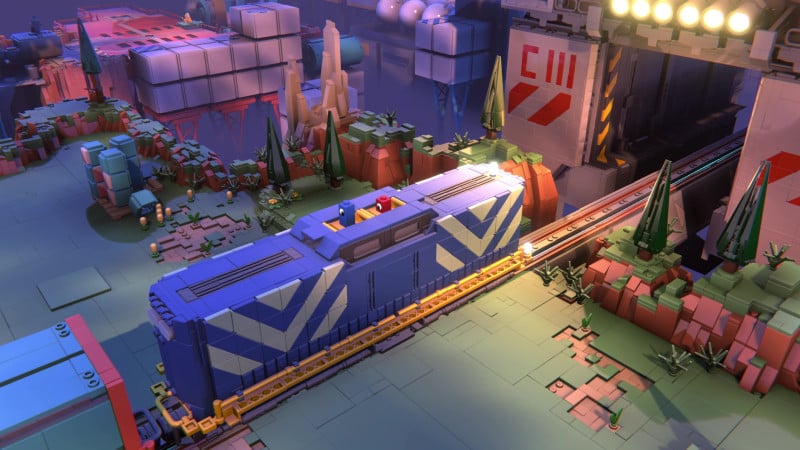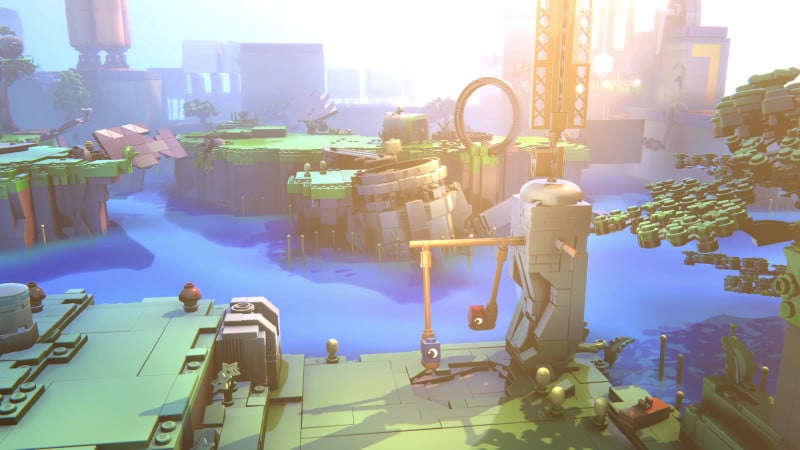Every completed Lego set is a collaboration between the designers and the builder; it’s fun both because a team made a beautiful set and because you’re the one who put it together. Lego Voyagers, a co-op puzzle platformer from Light Brick Studio, made me feel the same way. Its adorable aesthetic and wordless storytelling make this brief adventure one worth sharing with family or a friend, but its distant camera angle and visual filters were frustrating obstacles on an otherwise picturesque road. At the end of the journey, though, my partner and I are the ones who completed the puzzle, and that makes it so much sweeter.
As a fan of couch co-op, I’ve been delighted to see a resurgence of two-player experiences over the past several years, and Lego Voyagers is an exciting addition to that lineup. Like Hazelight Studios’ Split Fiction and It Takes Two, Lego Voyagers is a strictly two-player experience: you cannot play it solo. Luckily, I have a fiancée at home now, and after taking one glance at the game, she was more than happy to play alongside me. If you don’t have a fiancée (which is fine, by the way), Lego Voyagers comes with a Friend’s Pass so that you can play for free with a friend online.
This game stars a pair of Lego pieces, one blue and one red, that goofily roll around the map, which is also gorgeously crafted from Legos. It’s visually charming, from its intricately crafted mountainsides to its minimalist animals, like butterflies represented by a tiny, flapping triangle. In addition to flopping around, one button is dedicated to “speaking,” which makes your respective Lego piece make a cute babble of gibberish. An exception to this is near a train section, where pressing the button makes the characters say “choo choo.” It’s as cute as it sounds.

While many surfaces are smooth, some have studs – those little nubs that allow Lego pieces to stick together – and the tap of a button here has your Lego guy lock onto the grid to move, allowing for more precise movement and platforming. That same button picks up loose Lego pieces, which you’ll use to build solutions to puzzles. I was slightly disappointed in this regard, solely because 80 percent of constructions are just bridges or ramps, but the last hour of the game cranks up the creativity to wonderful effect. You can also attach yourself to the other player to link up into one long Lego piece and roll around together.
In addition to building sequences, Lego Voyagers has you solve simple puzzles, like bringing generator pieces from one area to another or operating machinery to help your partner reach distant platforms. My favorite genre of puzzle is when the game has you collaborate to pilot a vehicle, like a boat or car, with one person steering and the other controlling the acceleration. These puzzles make the most of the game’s co-op nature, and I understand why single-player isn’t an option.
Lego Voyagers is also a platformer, which I did not enjoy as much as the puzzles. You can use the build button to snap your character to studs in surfaces, allowing you to zip to platforms you need to reach, but these platforms are usually just a single stud wide and barely the full length of your jump, so some sequences take a few attempts. This only becomes frustrating because of the distant, angled camera. Lego Voyagers rightfully wants to show off its beautiful visuals, but this means making the players very small on the screen. When you combine that with a fixed camera and visual effects like bloom, depth perception is a challenge, and trying to make precise jumps feels unintentionally difficult.
Lego Voyagers doesn’t punish you for dying, but some of the platforming sequences are just messy enough that I worry whether a co-op party of two young kids would be able to make it through. Couple that with one particularly difficult rocket minigame near the end, and I’d go as far as to say that, despite its extremely kid-friendly aesthetics, I’d recommend this game for slightly older kids, maybe 10 and up, who might have an easier time getting through it.
Despite my misgivings with the platforming, however, the story more than makes up for it. Despite a vague start, you’ll know exactly what’s going on by the end, and it’s a stunning, bittersweet tale. The last hour in particular is so effective and simple that it’s become one of my favorite story moments of the year – if you start this game, you owe it to yourself to finish it.
While I wish it had an adjustable camera or the ability to tweak visual settings on console, I had a great time regardless. Ultimately, whether it’s online or local, the dedicated two-player experience is Lego Voyagers’ secret weapon. The game is intentionally abstract and open to interpretation, so you’ll fill in the gaps with your partner: you create a relationship between your Lego avatars, shorthand for game terms to get through levels, and eventually build a new, player-specific version of the game for yourself. Light Brick Studio did a great job designing Lego Voyagers, but the experience I built with my partner is what will stick with me.

